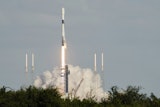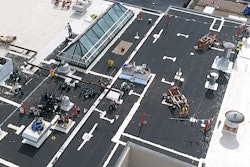
One way or another, almost all processes reveal themselves via changes of temperatures. This makes thermal imaging a very powerful tool in various applications to determine status, by revealing apparent surface temperatures, of different types of equipment. Thermography’s role has become more pivotal in electrical and mechanical equipment, industrial processes, building diagnostics and research and development. The main needs of all these applications were the prime drivers of the functions in thermal cameras. These needs also helped dictate which additional technologies were required and implemented to achieve the final result from the camera. While thermal imaging technology has evolved over the years, situational usage (applications) has not, nor has the way we interpret thermal images.

Technology Developments In Infrared Cameras
The first infrared cameras were massive and therefore bulky, complex devices. Operating one was difficult and required extensive training. Despite evolutions and advancements with infrared cameras, thermography training programs are highly valuable. The current state of infrared cameras is exciting, as these devices can be integrated with other wireless tools and condition monitoring software to reveal a more complete picture of equipment health. Three current features of higher end thermal imaging cameras are:
- Auto focus and manual focus options help speed up thermal inspections. Focus is the single most important thing to ensure when conducting an infrared inspection. Improper focus will lead to incorrect temperature measurements (from several degrees to several tens of degrees) depending on the camera. Lack of detail on critical features and poor thermal signatures leads to misdiagnosis of problem areas. All of these failures waste time and money. With thermal imagers users can change all other settings that define the image, like the color palette, level and span, emissivity and background (reflected) temperature settings later on in software, but cannot correct for an unfocussed image by any means. It is therefore very advantageous to have a thermal imager with auto focus that consistently produces pristine images.
Some higher quality infrared cameras fuse technology taken from laser distance meters to precisely calculate the distance to the intended target with a laser, then focus the camera to that exact spot. Auto focus provides convenience and time saving opportunities in most situations, but what if the situation calls for a very precise focus adjustment? In these cases, some infrared cameras have advanced manual focus accessible via an encoder wheel on the lens. This gives complete control to inspectors.
With the assumption of producing 200 thermal images per day, it can take approximately 15 seconds to manual focus one image — adding up to 50 minutes of focus adjustments per day. On the other hand, with the same daily output auto focus can reduce the focus time to second per image, thereby reducing the time spent making focus adjustments to a mere 3.5 minutes per day.
- Smart batteries that are rechargeable and field-replaceable have become the norm. The higher quality, lithium ion batteries often include LED displays that indicate the charge level. A quick glance lets maintenance technicians see the battery’s status both at the start of the inspection and while working in the field — a simple yet impactful feature that generates confidence in the equipment helps them better plan the day’s inspections.
- Higher resolution images provide in-depth detail reducing the overall equipment scanning time and help pinpoint apparent temperature anomalies even faster, saving the inspector time. In addition, more advanced infrared cameras combine full infrared images and visual images. This provides automatic blending levels of the image and can also be used to help focus the thermal image, because the visual and thermal image will be aligned at the focus point. The blended image can be viewed in picture-in-picture mode, in addition to full screen, or a combination of the two. These feature helps the user to get the best of both worlds in their image, thermal and visual allowing them to see the equipment details and features easily.

Thermal Inspections Today
As maintenance operations span repairs to electrical, mechanical or plumbing equipment or the building fabric, there are plenty of use cases that demonstrate the high impact thermal inspections can have. In a typical example, a customer would need a full inspection of their electrical, mechanical or building system’s installation and produce proof of status and any faults. They use a thermographer (who could also be an electrical or mechanical engineer) to inspect their facility with an infrared camera to uncover faults and make repair recommendations, or even carry out the repairs.
Before starting an inspection, the thermographer will ensure that besides the thermal imaging camera he has all the other necessary tools and equipment to carry out a full detailed and useful survey.
They suit up with appropriate personal protective equipment (PPE), or are accompanied by a qualified person to assist in the work, as they will need to access electrical cabinets. These are opened for inspection and thermal images are captured, either for reference or used in the report advising corrective actions.
In electrical systems excessive heat and hot spots need two conditions: current and resistance. An experienced pair of eyes will often identify the resistance, which is visible in the form of corrosion. However, an inspector cannot see the current, so the minimal toolset carried could include a current clamp, a two-pole tester for checking live systems, and a multimeter.
They will employ a digital or analog note-taking system for logging the circumstances surrounding the image for later analysis. Some contemporary cameras now have the capability to add textual annotations or voice recordings to better paint the thermal picture.
Other tools that may be carried in order to measure and record the working environment’s conditions both inside and outside — such as wind speed, humidity, and ambient temperature.
Also accompanying inspectors are spare batteries, a spare SD card, and their laptop for storing all thermal images for to review after completing the inspection
A quick scan should be done to identify potential problems and to find the optimal location and angle to get the right image. To capture the right image, inspectors need to focus and squeeze the thermal imager’s trigger to freeze the image frame. After checking the results for quality, they save the image. If the image is acceptable, the thermographer adds information about the inspection conditions, objects of inspection, location, load and other information that may be called upon during a deeper analysis.

The Future: Data Collection And Correlation
Innovations in wireless test tools are a current trend in infrared cameras. These technologies enable tools to connect with a smartphone application via Wi-Fi and condition monitoring software as part of predictive maintenance programs. This adds transparency and data logging to workflows and equipment health statuses. Sharing data, including thermal images and visible light images, is possible thanks to encrypted cloud computing storage. In a basic way, the future of infrared cameras is tethered to other wireless test tools such as digital multimeters, vibration testers, clamp meters, power quality analyzers, oscilloscopes, energy loggers, mA loop calibrators, and more. Portable monitoring sensors and three-phase power monitors are also as part of a robust condition monitoring maintenance program.
Teams can then have the ability to wirelessly connect multiple instruments to smartphones, while collecting measurements at the same time. When an infrared camera is connected to such a smartphone app, saving thermal images automatically pushes them to the app. This solves for data storage and simultaneous measurements. Data is automatically saved on smartphones, eliminating the need for handwritten notation. Data will automatically synchronize with cloud storage, whether it is via Wi-Fi, 3G or 4G, at the very moment an internet connection is established. The data can be accessed via smartphone or with any web browser from any location.
As posited above, the future state of infrared cameras might be further unification with condition monitoring software and wireless test tools. At present, however, advancements in focus options, smart batteries, and higher resolution image capture have evolved alongside the need to make thermal inspections more detailed and proficient.
Sat Sandhu is a Thermography Services Manager for Fluke, covering Europe, the Middle East and Africa (EMEA) and Asia Pacific. Sandhu has worked in electronics design and thermal imaging for over 36 years.























